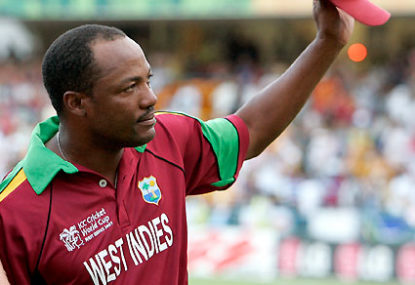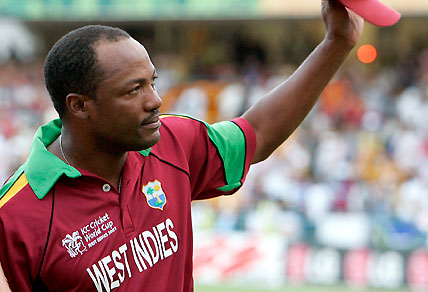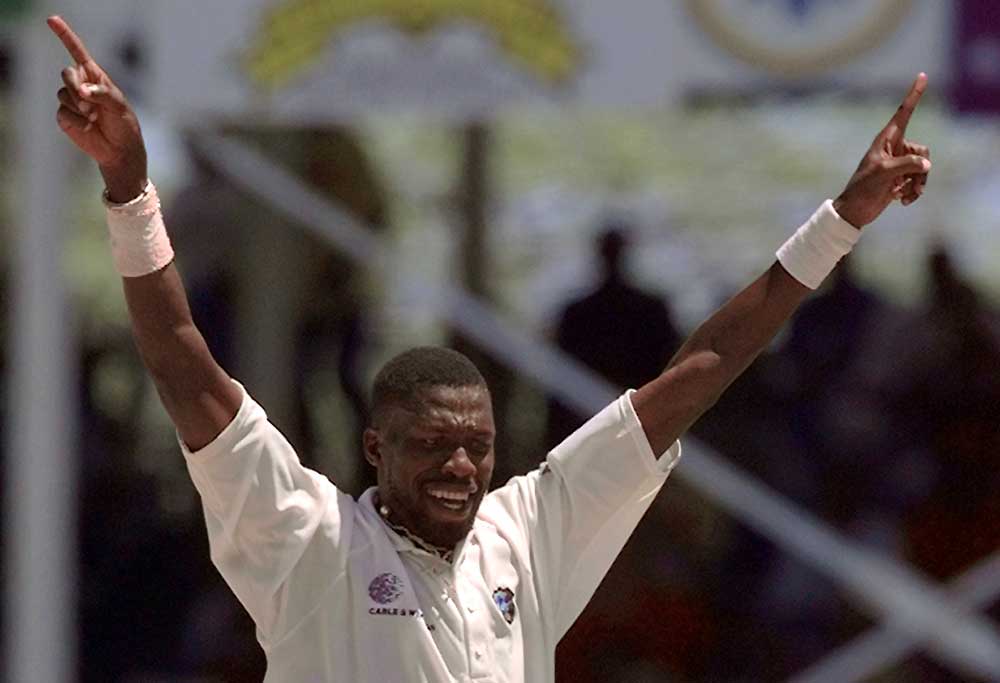Bairstow goes ballistic, clubs 45-ball ton to spearhead highest T20 run chase EVER
Johnny Bairstow has hit his way back into form with a 45-ball century as he steered his side to a record-breaking win, easily chasing…

It might come across as curious that I’m writing a review of the 1992-93 World Series Cup, but if you don’t like curious, you simply won’t enjoy this piece.
The series featured hosts Australia, world champions Pakistan and the then-mighty West Indies.
Names such as Dean Jones, Steve Waugh, Des Haynes, Curtly Ambrose, Wasim Akram, Javed Miandad and Waqar Younis lined up. There were some tense matches, but none of them ran with the conventional pre-tournament ‘classic cricketing contest’ hype.
These matches were weird.
Given the course they took, it’s also weird to think they are merely a footnote of One Day International cricket today.
Match 1: Pakistan vs West Indies (Perth)
The series began with a meeting between Pakistan and the West Indies. It’s difficult to see this as the most dynamic opener to a tournament attracting international attention.
Cricket Australia now spurn the concept of neutral matches and tri-series, fearing they don’t attract enough attention.
The WACA which hosted that particular match, constantly fights the resistance of the powers-that-be, who found the significant time difference between the west and east coast an inconvenience rather than a curiosity.
Consequently, the nature of the post-Packer cricket television does not sit well with those of us who yearn for the ‘good old days of colour broadcasts’.
Even though Packer was intrinsically focused on cricket as product, he remained a cricket fan throughout. Everyone since has been solely a programmer. When you’re seeing the same re-run of some forgotten TV show for the 14th consecutive summer during a rain delay, you know whoever chose to put it on isn’t a fan of cricket highlights.
Pakistan appeared to apply the same tactical nous in the tournament opener that served them so well during their World Cup triumph in Australia and New Zealand the previous summer.
After some initially slow progress, they trumped the Windies comfortably by five wickets. Neither side passed 200 in the match, a fact attributed to the lack of pace in what was traditionally a firm, more lively wicket.
Match 2: Australia vs West Indies (Perth)
If pundits assumed things would improve, they were wrong. The second match of a Perth double header saw Australia take on the West Indies.
Australia crawled to 160 from their 50 overs, with Phil Simmons the pick of the bowlers ending up with 2/22 from his ten overs, while no other bowler went at more than three and a half runs per over
Needless to say, the Windies overhauled the target comfortably, just one wicket down and with 12 overs to spare.
Match 3: Australia vs West Indies (Sydney)
The third match remains one of the most bizarre ODIs ever played.
Persistent summer rain in Sydney days before the match turned the centre square almost as green as the outfield, with SCG curator Peter Leroy quoted as saying, “What we need is strong wind and sunshine, we don’t want any more rain at all. We’ve tried a helicopter for an hour, and used super-soppers.”
Further rain on match day increased the potential for a complete abandonment. Instead, after truncating the match to 30 overs per side, the umpires ordered play to begin on one of the greenest wickets you will ever see.
West Indies captain Richie Richardson won the toss and unsurprisingly elected to bowl first. No Australian batsman dominated, nor looked comfortable during their short time at the crease as the Windies’ pace attack exploited conditions expertly.
Still, top order batsman Phil Simmons was tossed the new ball, and surprised again with 3/11. Dean Jones’ hard fought 21 was the top score from Australia’s total of 9-101.
It was expected the West Indies would find the going tough, but perhaps not equally tough. After all, the target was just 102. The West Indies though, were bowled out for 87.
Mark Taylor was worth his weight in green and gold on his captaincy debut with Allan Border out of the match due to injury.
Figuring there was no need to many keep fielders back, he was rewarded with four catches of his own at first slip. All the bowlers contributed in one of the few occasions during the Windies’ era of dominance that Australia weren’t intimidated by them.
Match 4: Australia vs Pakistan (Hobart)
This clash at the Bellerive Oval saw a return to normal transmission, for 99 of the 100 overs at least.
Chasing 229 to win, Pakistan hung their hopes on a profitable partnership between Rashid Latif and Asif Mujtaba. That was until Latif was run out for 39, totally losing sight of the direct-hit return from Craig McDermott, and standing startled a few feet short of the crease before accepting his fate.
Mujtaba was Pakistan’s last hope, but with 17 needed to win from the last five balls, that hope was very slim. Mujtaba and Aaqib Javed managed ten from four before Steve Waugh bowled a waist-high full toss on the last delivery that Mujtaba hoisted into the stands for six.
The tie was only the fifth in ODI cricket. The postscript to this match endeavoured to carry on the ‘weirdest summer of cricket’ tag, but in reality, one in 100 overs is all people will remember.
Match 5: Pakistan vs West Indies (Adelaide)
Pakistan’s tenacity had been on display in their early performances, but no sooner had the green machine looked in blossoming form did it disappear in the muggy humidity of Adelaide.
Once again, rain intervened in their match against the West Indies, but a more sizeable 42 overs per side were bowled. The West Indies’ stop-start innings was not helped by the interruptions, and a total of 7-177 was not likely to be enough.
But that molehill was made to look like a mountain when the West Indies went into the field. So often they looked like a team who wrote the book on how to play limited overs cricket but dropping five catches in Pakistan’s reply made them look vulnerable.
That doesn’t even include one Salim Malik skier that three fielders attacked, but all backed out of catching.
Pakistan happily trundled to 1-116 when Ramiz was run out after a sudden injury to Salim Malik rendered him immobile.
In turning for the third, Malik turned the fortunes of his team radically. He was dismissed not long after, runner in tow, when Phil Simmons took a terrific low catch that enhanced his reputation as anything but a top order batsman.
Pakistan then panicked as Inzamam added one more to his bulging catalogue of comical run-outs, while Mujtaba was run out thanks to some spritely athleticism from bowler Anderson Cummins in his follow through.
Pakistan lost a ridiculous 7-45 to fall short of the target by four runs, leaving them with a record of a win, a loss and a draw.
Match 6: Australia vs Pakistan (Adelaide)
From then on, Pakistan’s World Series campaign didn’t show brilliance, but rather illuminated their shortcomings.
Australia faced them in Adelaide in Match 6, and despite a stunning late order assault from Inzamam-Ul-Haq who scored 60 off 70 balls and Wasim Akram who added 36 at a strike rate of better than 200, an otherwise spineless batting and ineffective bowling display saw Australia march home by eight wickets.
The chase was never in doubt as Mark Taylor led the way with 78.
Match 7: Australia vs West Indies (Melbourne)
Australia were left wishing their form could have carried over to Melbourne against the West Indies though, despite picking up a victory thanks to the brilliance of Mark Waugh.
The MCG’s new outfield which was re-laid after the AFL grand final the previous September was under-prepared, with large patches of sand still widely apparent.
Groundstrokes on the world’s biggest cricket ground became valueless. So, like in Perth, Australia’s top order struggled for impetus against the Windies’ quicks. Only a face-saving 57 from Mark Waugh (intelligently hitting over the top to find the boundary) dragged Australia to what looked like a non-threatening 8-198.
With Brian Lara and Richie Richardson batting as if they were facing a schoolboy attack, captain Mark Taylor again turned to Mark Waugh to deliver.
He proceeded to take each of their wickets within a few overs before the West Indies channelled Pakistan to lose 8 for 36, and the match by four runs.
Mark Waugh followed up his runs and two wickets with three more breakthroughs. Like Allan Border in Test cricket, it was baffling that Waugh’s bowling wasn’t used more often. It was even weirder to think history would nearly repeat itself in the 1996 World Cup semi-final as another monumental choke saw the West Indies finish second.
Match 8: West Indies vs Pakistan (Sydney)
The gremlins in the Sydney pitch during the third match had disappeared by the time the tournament returned in Match 8, but looking at the scoreboard won’t convince you.
The West Indies faced Pakistan, and Des Haynes all but carried his bat, injured knee and all, to score 96 until he swiped at a Wasim Akram full toss, missed, and lost his off stump.
This was the closest any batsman came to scoring a century in the whole tournament and looking at the performances of the batsman and the quality of bowlers, it’s amazing Haynes made it so close. The remaining West Indies batsman struggled as they posted 9-214 from their 50 overs.
What followed defies belief and description, but here’s an attempt at one.
Phil Simmons again opened the bowling with the kind of success many expected from his batting, but this time it was different.
In his ten overs, Simmons sent down 58 dot balls, conceded just three runs, bowled eight maidens and took four wickets. In the modern age, where a batting strike rate of 100 makes you an also-ran rather than a superstar, this is unfathomable.
Simmons’ probing spell reduced Pakistan to 5-14 in 12 overs, with only Inzamam-Ul-Haq (a two in Simmons’ fourth over) and Wasim Akram (a single in his eighth) making any dents in his figures.
This amazing performance had more to do with Pakistan’s ineptitude than quality bowling though, as Pakistan were steamrolled for just 81 from 48 overs, going along at less than two runs per over.
Rashid Latif only had eyes for salvaging some faint pride in an otherwise abysmal performance, aiming to bat the 50 overs out rather than score runs. He was the last man out for eight from 72 balls.
Richie Richardson’s assessment of the record-breaking performance? “Phil bowled particularly well but the wicket helped the bowlers a little.”
Match 9: Pakistan vs West Indies (Brisbane)
After some Test cricket (which threw up its own share of bizarre moments), Pakistan re-joined the fold in Brisbane once again against the West Indies.
The break did Pakistan no good at all. This time it wasn’t Simmons that tormented them though, as he didn’t bat or bowl – not that there was much need to.
Pakistan were bowled out for a mere 72 in 24 overs with the top six batsmen combined for a total of just 12 runs. Ian Bishop was the bowling star this time, taking 5 for 25 while Curtly Ambrose, an almost inconspicuous character at this stage in this series, took 3/13.
While panicking at the sight of chasing a small target was a common sight in this tournament, there was none here.

Match 10: Australia vs West Indies (Brisbane)
A day later, Australia rounded out the ‘panicking at the last hurdle’ trifecta, losing by seven runs to the West Indies.
Ian Healy (in his longest ODI innings) and Mark Waugh looked to be nudging Australia to victory before Waugh was run out for 54. Australia lost 5-32 at the end of their innings (with no less than four run-outs) to be all out for 190 chasing 198.
The West Indies also managed victory without star bowlers Curtly Ambrose, Phil Simmons and Ian Bishop. The psychological boost went down well, with the West Indies comfortably qualifying for the finals.
Match 11: Australia vs Pakistan (Melbourne)
The remaining two preliminary matches gave Pakistan the chance to regain some form and self-respect, as the finals were now out of their reach. Australia batted first in Melbourne in match 11 as they found, once again, that boundaries came at a premium.
Six fours and one six peppered Australia’s innings, yet they still managed to pump out 6-212, thanks to a hustle-and-bustle 84 from Dean Jones.
He was on course for a century, until being knocked over by a Waqar Younis thunderbolt. Pakistan’s dependence on the late overs flurry, like in World Cup, cost them dearly here as the top order’s sluggish progress gave the middle order too much to do.
Pakistan finished on 7-180. More of the same was to be expected in the last of the preliminaries.
Match 12: Australia vs Pakistan (Sydney)
As it happens, Australia benefited from its most profitable batting performance of the tournament as Mark Taylor, David Boon and Steve Waugh each made 50s in a total of 6-260.
Pakistan performed relatively well, but were ultimately never in the hunt, and fell short by 23 runs which left Australia and the West Indies to battle it out in the best of three finals.
Final 1: Australia vs West Indies (Sydney)
The West Indies batted first in the first final and in one of their more enterprising batting efforts, finished on a competitive 8-239. While Australia started well, Dean Jones did nothing to help the cause.
His now infamous request to Curtly Ambrose to remove his white sweatbands baffled and angered Ambrose, and some deadly accurate bowling followed.
The ensuing contest against Jones made for particularly engaging viewing, but for all that has been mentioned since about the incident, that fact is Ambrose didn’t take Jones’ wicket that night. That honour belonged to Kenny Benjamin, catching Jones unawares with a short ball that found the hands of Phil Simmons.
Mark Waugh again started a recovery mission but, like in Brisbane, a clumsy run-out cost him his wicket for 51. Later, Curtly Ambrose bowled what must surely be the most telegraphed slower ball in the history of cricket, and Ian Healy duly missed it.

Smiles, joyful and ironic ones alike, shone on the players as Ambrose finished without Jones, but with 5/32. Australia were bowled out for 214.
Final 2: Australia vs West Indies (Melbourne)
The pattern of the last few matches saw very little in the way of weird cricket, but the slow outfield of Melbourne beckoned for the second final, and normal transmission was to resume.
Australia’s start was encouraging enough, but after scoring 24 by the fourth over, Australia then faced 37 more overs, hit a solitary boundary (an edge off Paul Reiffel), scored just 108 runs and lost all their wickets.
Ambrose was again the star, taking 3/26, while Ian Bishop (2/33) and Carl Hooper (2/28) were terrific in support. Mark Waugh compounded frustration with another run-out and if not for his elegance at the crease, he would have been lumped together with Inzamam in the bad running stakes.
The total of 147 was made at a snail’s pace and despite their form and ability, the West Indies didn’t fare too much better.
Trembling initially at 3-23, Brian Lara (60) and Carl Hooper (59 not out) all but saw them to the World Series title. Once again though, the difficult outfield saw any chance of a low-target blitzkrieg an impossibility.
Lara faced 100 balls and Hooper faced a win-at-any-cost 132 balls, an innings which would be considered slow even in a Test. Australia fought back late in the innings to claim a few more wickets, but none to realistically push for a win.
The simple fact was the West Indies were overall the best side.
Phil Simmons won the Man of the Series award (even though his primary function could only net him 88 runs at 17.6) while Curtly Ambrose won Man of the Finals (deservedly, although Lara could feel a little cheated) and Richie Richardson held the trophy for the West Indies.
As time inexorably marches on, this series becomes more and more lost in the annals of ODI cricket. Since then, we’ve seen some remarkable ODI players take the stage, with records have been set and broken.
Thanks to the emergence and success of Twenty20 cricket, weird cricket is no longer a rarity, but a certainty, but let these magnificent modern endeavours not overshadow what we saw in the World Series of 1992-93, the weirdest summer of cricket ever.